This article was published in Scientific American’s former blog network and reflects the views of the author, not necessarily those of Scientific American
We’re all used to the idea that amazing fossil discoveries – sometimes wholly unexpected and totally out of left field – are found on a regular basis, and if anything’s clear about the fossil record it’s that a hell of a lot of stuff remains to be discovered. If we think about the fossils that will be discovered in the future, many will be completely new. But others will be better examples of known species, or will represent the sort of species that we’ve actually already predicted to exist. In this article I’m going to provide a ‘wish list’ of fossils that I’d really like to see discovered. If any of them do exist or are findable, they’re going to be very rare, and indeed some are so rare – because they represent animals that were surely geologically short-lived or unlikely to have ever been preserved – that they may well never be discovered. But what the hell.
Caveats: seeing as this blog is called Tetrapod Zoology, the fossils are all tetrapods. Furthermore, my wish list is populated by creatures specific to my own idiosyncratic interests and other workers would surely come up with a very different one. This whole line of discussion was inspired by a question posed by a colleague; so thanks to him for providing the inspiration. It might be fun for other bloggers to come up with similar lists of their own, or discuss their own ‘wish list’ fossils in the comments section (he says, optimistically).
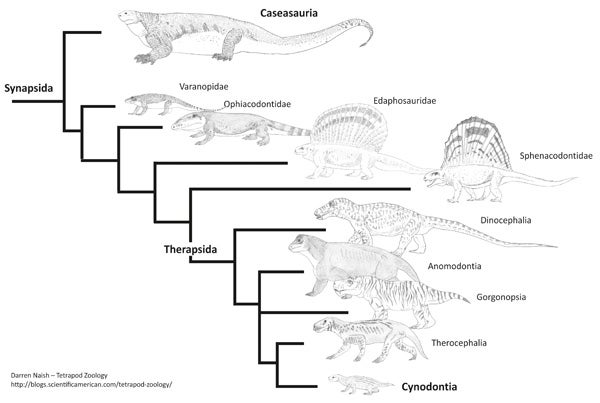
A cladogram of stem-mammals: the enormous tetrapod group known properly as Synapsida. Credit: Darren Naish
On supporting science journalism
If you're enjoying this article, consider supporting our award-winning journalism by subscribing. By purchasing a subscription you are helping to ensure the future of impactful stories about the discoveries and ideas shaping our world today.
An early synapsid with extensive soft tissue preservation. At the risk of seeming like someone obsessed with soft tissues and life appearance (read on and you’ll get what I’m saying), high on my list is the discovery of an early synapsid – a stem-mammal – that provides us with good information on integument. It looks likely at the moment that hair, whiskers and so on evolved in cynodonts prior to the origin of mammals (or mammaliaforms if you prefer), but were these features present any earlier than this? Did gorgonopsians and dicynodonts and so on possess whiskers or body hairs? Did these animals have a smooth skin with sebaceous glands? Or were they still scaly?
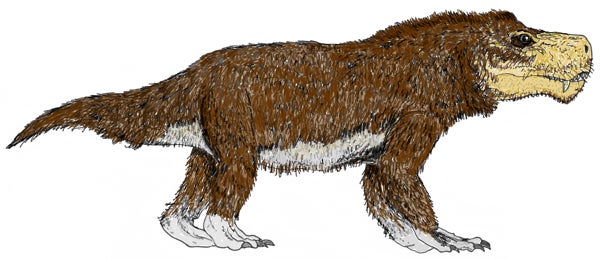
I added fur to my Dinogorgon illustration - because surely fossil integument will reveal it to be so, right? Err, maybe not. Homage to Bakker and Paul. Credit: Darren Naish
Yes, there are supposed to be a few fossils that help answer these questions (that oft-mentioned patch of skin of Estemmenosuchus, for example), but they’re not sufficiently satisfying. A nice fossil – an articulated dinocephalian or anomodont perhaps, with extensive, well preserved areas of skin and associated tissue (throw in pigment traces and musculature too) – would make many palaeontologists very happy.
A little pterosaur in amber. The idea that we might discover intact Mesozoic animals preserved in amber once seemed like a pipe dream. But no more: we now have large numbers of Cretaceous lizards in amber, a partial tail from a small non-bird theropod, and assorted archaic birds, including the better part of a baby enantiornithine.
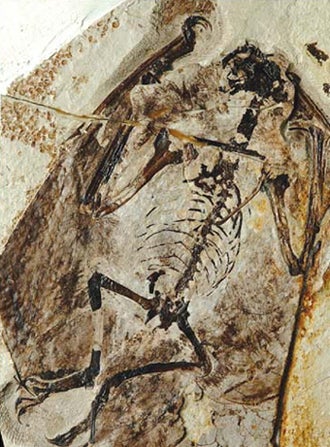
Jeholopterus: a Chinese anurognathid pterosaur with pycnofibers, wing membranes and other soft tissues preserved. Nice. Now imagine a version preserved in amber. Credit: Elgin et al. Wikimedia(CC BY 2.0)
But there’s so much more that we need, and high on my list is a tiny pterosaur (thrush-sized or smaller) either representing a very small adult or a juvenile of one of the bigger species. Thanks to fossils that come from places of exceptional preservation (like Liaoning Province in China and Karatau in Kazakhstan), we already have a reasonable handle on the life appearance of small pterosaurs (Unwin & Bakhurina 1994, Kellner et al. 2009, Witton 2013). BUT they’re always squashed flat and ambiguous on various of the details. A complete, 3D little pterosaur in amber would give us a far better understanding of whatever’s going in with integument (the distribution of ramphotheca, pycnofibers and scales, if present), the precise form and anatomy of the wing membranes, and such things as nostril and ear position and size.
The mummified face of a non-bird dinosaur. As you’ll know, debate continues over the facial soft tissues of Mesozoic dinosaurs: this is one of the things dinosaur specialists talk about the most… sauropodomorphs, theropods and ornithischians all remain the subject of extensive argument, disagreement and uncertainty. How extensive was beak tissue in those taxa that had it? What’s the deal with ‘lips’, ‘cheeks’ and other extra-oral tissues around the jaw margins? How exposed were the teeth, if at all? Were structures similar to the facial receptors of modern crocodylians present in some groups? Were there whiskers, filaments or other integumentary structures on the snout and elsewhere?
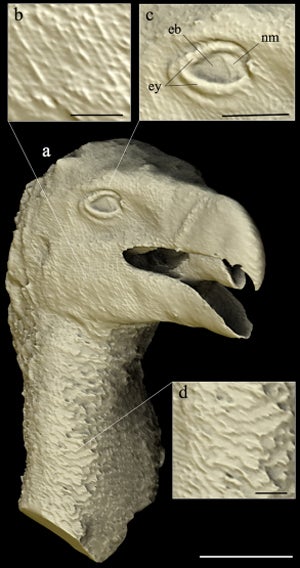
A griffon vulture was entombed in an Italian pyroclastic deposit, and is preserved as a space in the block. Iurino et al. (2014) scanned the block and were able to reconstruct the animal in 3D. There is, in principle, no reason why the same couldn't happen with a Mesozoic animal preserved in the same way. Credit: Iurino et al. 2014
As is clear from recent publications relevant to this issue (Hieronymus et al. 2009, Barker et al. 2017, Carr et al. 2017), we likely aren’t going to get unambiguous answers on these issues from skeletal fossils alone. I put it that we either need an immaculate, mummified face (Stephen and Sylvia Czerkas said similar things back in 1990, specifically in connection with information on the sauropod nasal region), or the complete impression of a face, preserved in a substrate like fine-grained volcanic ash. The idea that such a thing might one day be discovered is not beyond the realms of possibility. I say this not only because we have Mesozoic dinosaur fossils that come from deposits where fine-grained volcanic ash surrounds their remains but also because we know of cases from recent history where animals have left impressions of their soft tissues preserved in the same way (Iurino et al. 2014). This idea is not original to me: I took it from my colleague Andrea Cau who blogged about it here.
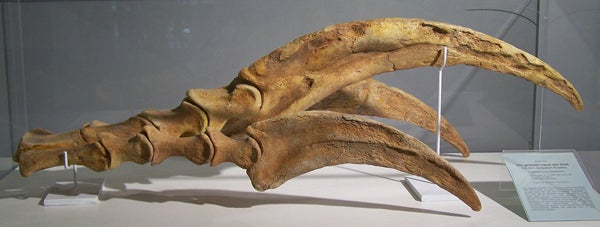
Everybody wants more Therizinosaurus. The longest of those unguals ('claw bones') are about 70 cm long. Credit: Woudloper Wikimedia(CC BY-SA 3.0)
The complete skeleton of Therizinosaurus. It seems trite to wish for the complete skeleton of a dinosaur known only from partial remains – after all, for years we were wish wish wishing that one day, one day, good material of Deinocheirus would turn up. Now it has, and we’ve moved on. But, whatever. Therizinosaurus – currently known from forelimb and a bit of hindlimb material only – is the biggest of the therizinosaurs and an argument can be made that we know enough about the members of the group anyway to already have a good idea as goes what it was like. But Therizinosaurus is a giant, potentially one of the biggest theropods of all. Not only would it be really, really cool to know exactly what it looked like (I guarantee it isn’t just going to be a super-sized version of Nothronychus or whatever), it will potentially show how members of the maniraptoran lineage evolved to cope with giant size. And this could actually have all kinds of interesting and important ramifications. Yes, I’m thinking of the poultry industry again.
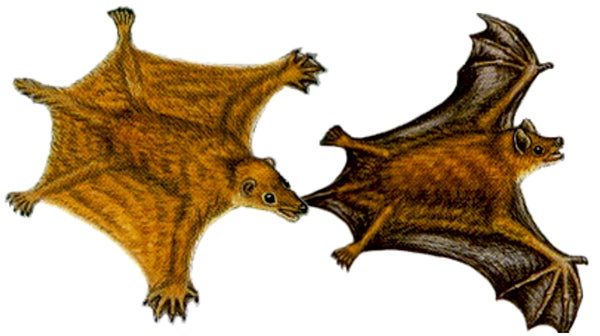
There have been several speculative efforts to reconstruct 'protobats' - these are the excellent illustrations by Fiona A. Reid (from Graham 2002). But... where are the fossils? Will we ever find them? Credit: Graham 2002
A complete protobat. Even today, there is no ‘Archaeopteryx for bats’: there are archaic, geologically ancient fossil bats that possess primitive features not present in later bats (Onychonycteris from the Eocene of Wyoming retains a full complement of wing claws and has wing and hindlimb proportions quite different from those of later bats), but they still have fully-formed wings and were evidently fully flight-capable. The lack of a compelling fossil protobat means that we lack data on what bat ancestors looked like and on the sorts of transformations their evolution involved: there are competing ideas on how bats originated, on the specific sort of locomotion that led to the evolution of bat wings and flight style, and on exactly where bats fit within the placental mammal radiation. People have had a few attempts already at guessing what protobats might have looked like, a topic I’ve covered here on a few occasions. The discovery of a complete fossil protobat – represented by a whole skeleton, not just by some little chunks of jaw or a few teeth – would help answer all of these questions and be an astonishing find.
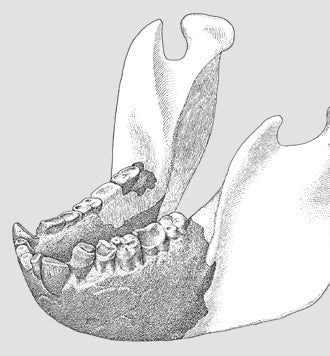
You don’t have to be an expert on fossil primates to be aware of Gigantopithecus. This ilustration of a lower jaw is from Simons & Ettel's (1970) magazine article. Credit: Simons & Ettel 1970
A complete Gigantopithecus. The famous Asian fossil hominid Gigantopithecus is – as everyone knows – represented solely by teeth and partial lower jaws. Fossils of this sort have been known to science since 1935 when Ralph von Koenigswald discovered the first examples in an apothecary shop in China; later finds were made in India. We’re not entirely sure what kind of hominid it is (though general thinking is that it’s a pongine), how big it was (extrapolations that make it super-sized may well not be valid), or what it looked like. There are three species, all equally poorly known [UPDATE: I forgot that two of those have recently been moved to the new genus Indopithecus, leaving only G. blacki as the real Gigantopithecus. Thanks, Cameron].
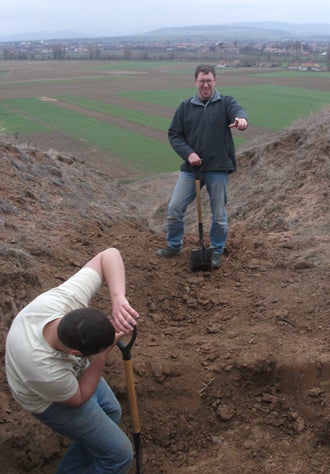
We will keep searching! Credit: Darren Naish
So, it would be really nice to know: finding a good Gigantopithecus skeleton would effectively end more than 80 years of speculation and extrapolation and resolve one of palaeoprimatology’s longest-standing mysteries. Ok, so Gigantopithecus might just turn out to be an especially robust, highly terrestrial relative of orangutans and other pongines. But it might also surprise us: good skeletal remains would allow us to either shoot down or, just possibly, endorse those proposals that it was hominin-like as argued by those who’ve linked it with their ideas about yetis and bigfoots.
And we’ll end it there for now. Believe me, I have other ‘wish list’ fossils too and maybe I’ll come back to this topic in the future. Many of the issues touched on in this article have been covered on Tet Zoo before. See…
Refs - -
Graham, G. L. 2002. Bats of the World. St. Martin’s Press, New York.
Hieronymus, T. L., Witmer, L. M., Tanke, D. H. & Currie, P. J. 2009. The facial integument of centrosaurine ceratopsids: morphological and histological correlates of novel skin structures. Anatomical Record 292, 1370-1396.
Iurino, D. A., Bellucci, L., Schreve, D. & Sardella, R. 2014. Exceptional soft tissue fossilization of a Pleistocene vulture (Gyps fulvus): new evidence for emplacement temperatures of pyroclastic flow deposits. Quaternary Science Reviews 96, 180-187.
Kellner, A. W. A., Wang, X., Tischlinger, H., Campos, D. de A., Hone, D. W. E. & Meng, X. 2009. The soft tissue of Jeholopterus (Pterosauria, Anurognathidae, Batrachognathinae) and the structure of the pterosaur wing membrane. Proceedings of the Royal Society B: Biological Sciences 277, 321-329.
Simons, E. L. & Ettel, P. C. 1970. Gigantopithecus. Scientific American 222 (1), 77-84.
Unwin, D. M. & Bakhurina, N. N. 1994. Sordes pilosus and the nature of the pterosaur flight apparatus. Nature 371, 62-64.
Witton, W. P. 2013. Pterosaurs. Princeton University Press, Princeton & London.